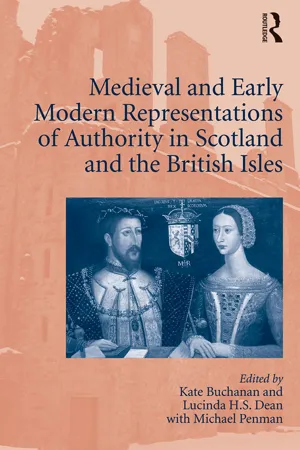
Medieval and Early Modern Representations of Authority in Scotland and the British Isles
- 284 pages
- English
- ePUB (mobile friendly)
- Available on iOS & Android
Medieval and Early Modern Representations of Authority in Scotland and the British Isles
About This Book
What use is it to be given authority over men and lands if others do not know about it? Furthermore, what use is that authority if those who know about it do not respect it or recognise its jurisdiction? And what strategies and 'language' -written and spoken, visual and auditory, material, cultural and political - did those in authority throughout the medieval and early modern era use to project and make known their power? These questions have been crucial since regulations for governance entered society and are found at the core of this volume. In order to address these issues from an historical perspective, this collection of essays considers representations of authority made by a cross-section of society within the British Isles. Arranged in thematic sections, the 14 essays in the collection bridge the divide between medieval and early modern to build up understanding of the developments and continuities that can be followed across the centuries in question.
Whether crown or noble, government or church, burgh or merchant; all desired power and influence, but their means of representing authority were very different. These essays encompass a myriad of methods demonstrating power and disseminating the image of authority, including: material culture, art, literature, architecture and landscapes, saintly cults, speeches and propaganda, martial posturing and strategic alliances, music, liturgy and ceremonial display. Thus, this interdisciplinary collection illuminates the variable forms in which authority was presented by key individuals and institutions in Scotland and the British Isles. By placing these within the context of the European powers with whom they interacted, this volume also underlines the unique relationships developed between the people and those who exercised authority over them.
Frequently asked questions
Information
Table of contents
- Cover
- Half Title
- Title
- Copyright
- Contents
- Acknowledgements
- List of Abbreviations
- List of Figures and Table
- Contributors
- Representations of Authority: An Introduction
- Section I Using and Reusing Internal and External Spaces
- Section II Pious Rituals and Military Display
- Section III Representing Female Power and Noble Authority
- Section IV Privileged Poetry, Music and Material Culture